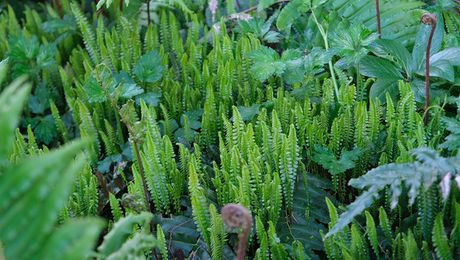
Gardening has been a lifelong passion for both of us. For more than 30 years, we’ve gardened both at home and professionally, and we love spending time outdoors. We built the patio garden on the back side of our house with entertaining and relaxing in mind. We wanted it to be an extension of the house—a series of spaces with cozy seating areas rather than one large rectangle, which can be difficult to make inviting. Conveniently located adjacent to the doors that lead into our sunroom and kitchen, the patio garden is a lively and versatile place to spend time outdoors during the warm months.
Gentle curves create unique spaces


The east end features the first of three distinct areas. Two chairs tucked next to the house by an overflowing planter make a favorite spot for morning coffee. From there, the entire patio is in view, with the curvature of the patio establishing transitions from one area to the next. Moving on, the central room is the largest and yet most secluded of the three patio areas, where the paving recesses toward the house. This alcove is lush with plants and surrounds an intimate dining area. In the west end, a third seating area is a great location for gathering with friends. It sits between the sunroom and the end of the stone wall.
Tall plantings embrace the space
The entire patio space is on grade with the house, but it is below the grade of the gardens beyond. The use of tall bold plants above the wall is intentional. Rather than growing the low creeping ground covers that are so often used on the top of walls, we created seclusion by choosing plants that grow at least 2 to 3 feet tall, such as Mexican sunflower (Tithonia rotundifolia, annual), ‘Carmencita’ castor bean (Ricinus communis ‘Carmencita’, annual), and ‘Lady in Red’ salvia (Salvia coccinea ‘Lady in Red’, annual). This makes the patio feel like an enclosed retreat without the need for walls on both sides. The plants also serve as a colorful backdrop for a whiskey-barrel water garden. A collection of colorful tropicals and annuals fills out the lower level of the bed and around the base of the barrels. Self-seeding annuals return each season to form a riot of color.

An edging of plants blurs the line between house and patio
Permanent and container plantings along the edge of the house obscures the distinction between the house and the patio, further reinforcing the feeling of enclosure within the space. These narrow beds are filled with ground-covering perennials, such as heucheras (Heuchera spp. and cvs., USDA Hardiness Zones 3–8), hostas (Hosta spp. and cvs., Zones 3–9), and epimediums (Epimedium spp. and cvs., Zones 5–9). Annual and perennial vines soften the corners of the house. It is here that we have fun experimenting with new plants and various combinations in containers. The shady alcove allows us to showcase the houseplants that grace the sunroom and kitchen window during the winter months. Orchestrating the containers with the houseplants, new annuals, and some tropicals presents a new look each year.
The patio garden has given us great pleasure over the years, and it allows us to play with colors and textures as well as new plants and old favorites as we redecorate our outdoor living room each year. Entertaining—whether for a few friends or a large gathering—becomes easy with such an inviting backdrop. And nothing beats seeing the hummingbirds and butterflies that gravitate to the space. It has become a retreat for all.
Design Lessons: Essential elements of a relaxing outdoor living space
1. Multiple seating areas

2. Sound and movement
A wine-barrel fountain masks street sounds and offers a soothing sound track to an evening outdoors. The moving water and the reflections on the water’s surface are energizing to the eyes.

Just as it does for your indoor living room, adding personal decorative elements to an outdoor room makes it feel more personal and comforting. They also provide visitors with a glimpse into your life.
4. Lush plantings
Plants are the ultimate outdoor decorations, and a variety of colors, textures, and shapes makes beds energetic and exciting to be near. They surround the space and make one feel part of the garden.

5. A sense of enclosure
Walls, tall plants, and elevation changes work together to create a space that feels surrounded, private, and secure. They also help to add privacy to the indoor spaces.
Mary Allinson and Shipley Allinson are horticulturists who live in Kennett Square, Pennsylvania.
Photos: Michelle Gervais. Illustration: Elara Tanguy
Fine Gardening Recommended Products

Planting in a Post-Wild World: Designing Plant Communities for Resilient Landscapes
Fine Gardening receives a commission for items purchased through links on this site, including Amazon Associates and other affiliate advertising programs.

Berry & Bird Rabbiting Spade, Trenching Shovel
Fine Gardening receives a commission for items purchased through links on this site, including Amazon Associates and other affiliate advertising programs.

















Comments
Log in or create an account to post a comment.
Sign up Log in